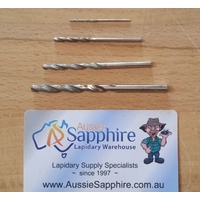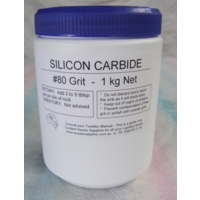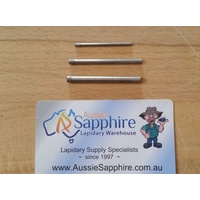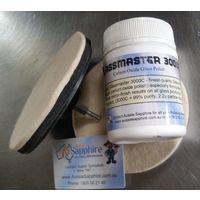You will need:
- some cerium oxide powder for the polishing (mix with water to make a slurry)
- a polishing pad (suggest soft calico, lambswool, felt or leather) mounted on a backing disc or wheel
- low speed drill (1500 rpm or less) to use with the polishing pad - polishing too fast will generate excessive heat and may crack the glass.
- a marking crayon or masking tape to mark the inside of the glass (use this to guide you when polishing)
- a cleaning cloth to wipe and allow inspection of the work area
- small spray bottle - use to apply mixture to glass and keep moist while polishing
How to Polish
- Mix some polish into water to a form a thin slurry (eg. milk-like consistency) - we suggest mixing in a small spray bottle which can be used to apply to polishing pad. Some people prefer a thin paste. Test which consistency you prefer. The pad can be dampened to help the slurry soak into the pad.
- Clean glass thoroughly to remove all traces of dirt and grease
- Apply polish mixture to the polishing pad
- Mark the inside of the glass with the crayon/tape to identify the area to be worked
- Mount pad/wheel in the drill and apply to work area.
- Move pad up and down, left and right in work area.
- NB: Keep the surface wet to prevent glass getting hot - if sufficient polish has already been applied, then just spray a fine mist of water to keep the area cool. Inspect regularly.
- Wipe off residue and inspect repair - keep working until polish is satisfactory
- Wash and store pad for later use when it is dry.
IMPORTANT - do NOT let the glass get too hot while buffing - the glass should get warm to the touch for best results but not too hot - control excessive temperature by spraying with water and keep the buffing pad moving continuously.
Deep Scratches
If the scratch can be felt with a fingernail, it is probably too deep to remove by polishing alone. You will need to grind out the scratch with progressively finer grit. This is a more specialised (and tedious!) job and it may be best to seek the advice of professionals in these cases.
For valuable pieces, please seek professional advice before attempting a DIY repair. Aussie Sapphire will not be responsible for damage caused by untrained users.
QUANTITY REQUIRED: we sell cerium oxide in quantities ranging from 100 grams up to 25 kilograms. If you have just a small scratch in an isolated area, then 100 grams will be sufficient. For a bit bigger job such as a car windscreen, we would suggest 250 grams. For larger areas, then you will need more but it really depends on the particular job.
NOTE: Some glaziers will call this product "jewellers rouge" - this is a misleading name as jewellers rouge is actually iron oxide and bright red in colour. Usually they will actually be referring to cerium oxide - a "peach" coloured powder which is particularly well suited to glass work. If you want to clean or polish glass - you will normally need to use cerium oxide, NOT iron oxide.







